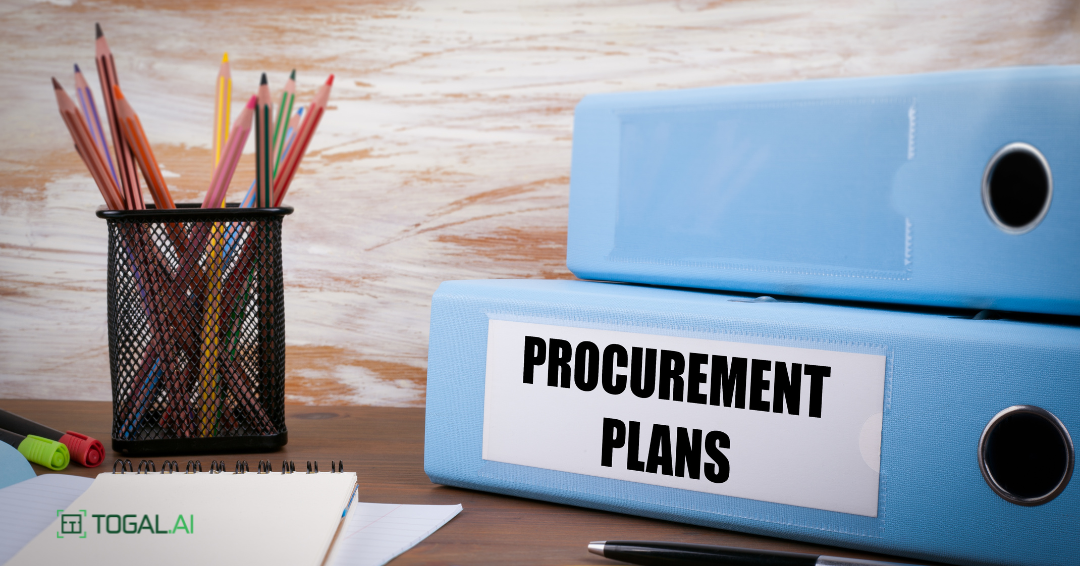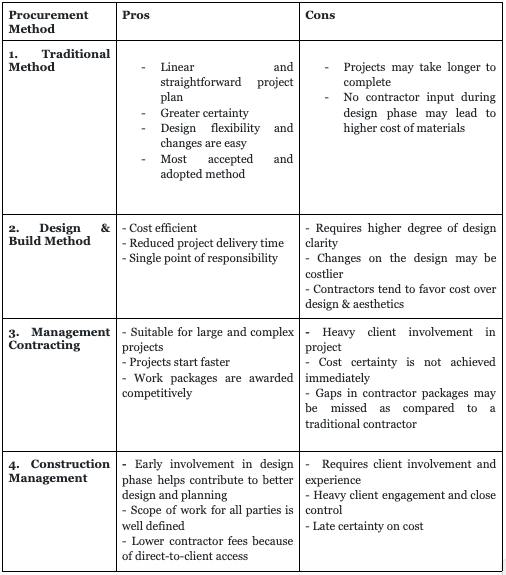Construction Procurement: Everything You Need to Know
Togal.AI
|
Understanding Procurement in Construction: Why It Matters and How to Get It Right
In construction, every successful project starts long before anyone steps onto the jobsite. One of the first and most critical stages is procurement.

When a new construction project is required by a client, the next step in turning the project into reality is determining the appropriate procurement method.
In order to maximize cost-efficiency, meet target timelines and increase the success of a construction project, the proper choice of procurement plays a paramount role in the overall strategy of a project.
What is Procurement in the Construction Industry?
In simple terms, construction procurement is the process of sourcing and managing all the labor, materials, and services needed to build a project.
It covers everything from selecting contractors and suppliers to overseeing the bidding process, contracts, and performance. A solid procurement plan ensures everyone involved (from the client to the subcontractors) is aligned on expectations, responsibilities, and deliverables.
Because procurement directly impacts a project’s budget, schedule, and quality, getting it right is non-negotiable.
The Construction Procurement Process: Step by Step
1. Determine the Procurement Method
Every project is different — size, scope, budget, and risk all play a part. The first step is deciding which procurement route best fits your project goals. Each method (design-build, traditional, management contracting, etc.) has its own approach to how teams are engaged and responsibilities are divided.
2. Documentation of Scope of Work
A well-written scope of work is the backbone of any construction contract. It clearly outlines what needs to be done, by whom, and to what standard. Clear documentation reduces confusion, prevents costly change orders, and keeps projects on track.
3. Bidding
A bid is a formal declaration of intent submitted by suppliers to provide a service required by the client and/or project and is usually done in a competitive environment that balances both cost efficiency and projected profit margins.
Construction bidding refers to the process of submitting a proposal to the client as a proposal to conduct or manage a particular project.
Bid documents are also known as Invitation to Tender, Request for Proposal (RFP), or Request for Quote (RFQ).
The bidding process is used by clients and contractors to identify suppliers that align with the requirements of a project. Bidding starts with the identification of requirements through step number 2. After all bids are received within the prescribed notice period, the bid evaluation process is performed by the client and/or its contractors in accordance with predetermined evaluation criteria.
Additionally, clients and contractors also use a Request for Qualification to shortlist vendors who then prepare a more detailed bid can be used as a prequalification process in order to trim down the list of bidders.
4. Awarding the Contract
Once the winning bid is selected, contracts are finalized and work begins. From here, procurement managers must ensure all parties deliver on their commitments and that the project complies with agreed terms and timelines.
5. Monitoring and Turnover
Procurement doesn’t stop at signing a contract. Ongoing monitoring keeps projects accountable. Performance tracking, change management, and documentation ensure a smooth handover when the work is complete.
Factors That Influence the Procurement Method
Choosing the right procurement strategy depends on a mix of factors, including:
- Project complexity and size
- Timeline and delivery speed
- Level of client involvement and experience
- Budget and financing structure
- Risk tolerance and flexibility
- Availability of qualified contractors and consultants
No two projects are identical. But ultimate goal for any bid is to balance control, cost, and collaboration in a way that fits the project’s needs.
Types of Construction Procurement Methods
There are four general procurement methods in the construction industry: traditional method, design & build method, management contracting and construction management.
The table below shows the advantages and disadvantages of each method.

1. Traditional Method: Design, Bid, Then Build
Pros: Clear cost certainty and well-defined roles.
Cons: Slower delivery and limited contractor input during design.
Also known as conventional, the traditional method has become the most widely used procurement method in the construction industry since the establishment of general contractors and independent consultants.
The defining characteristic of a traditional method is the separation of the design phase and the construction phase.
Under this route, the client appoints a separate consultant exclusively for the design phase who then turns over all documentation, drawings, work schedules and bills of quantities.
Contractors are then invited by the client to submit bids for the construction of the project. The contractor with the most competitive bid wins the project.
The contractors then set out to build the project according to the design given by the separate contractor. It is important to note that the contractor has no input on the design phase.
This linear approach helps create greater cost certainty since estimates are submitted on the bids based on the design. Changes in the design are also easily incorporated as long as it is in the design phase.
This approach can, however, be slower than other forms of procurement, as the contractor is appointed only after the design has been finalized. Moreover, the contractor will not be able to contribute to improving the buildability or packaging of the design as it develops.
The lack of contractor engagement during the design phase may also lead to a higher cost of materials since the designer did not receive valuable input from the contractor that could otherwise have provided cost-effective proposals and solutions.
2. Design & Build
Pros: Faster delivery, single point of responsibility, and strong cost efficiency.
Cons: Less client control over design details — contractors may prioritize budget over aesthetics.
In this procurement method, a sole entity or main contractor is appointed to design and build the project. Design and build companies usually include a combination of in-house architects and construction personnel.
Under this setup, it is the contractor's responsibility to design, plan, organize, control, and build the works in accordance with the client’s requirements. Design and build methods offer the advantage of having most of a project’s labor requirements under one firm - this increases the work efficiency considerably.
This type of procurement is the simplest of all because there is only one point of responsibility over the whole project which makes this type very cost efficient. Project delivery or time to completion may also be fast-tracked since the design and build is governed by one team and work takes place simultaneously during the design and build phase.
Once the contract is handed over, the client does not have direct control over the contractor's detailed design and in this regard some contractors are inclined to prioritize cost-efficiency over design quality.
3. Construction Management
Pros: Early CM involvement improves buildability and collaboration.
Cons: Requires experienced clients and can lead to less cost certainty, as the CM isn’t financially liable for overruns.
A procurement method in which works are fulfilled by subcontractors who are managed by a construction manager that acts as the client's agent or point person during the project's lifecycle.
In this setup, the client has full responsibility for employing the sub-contractors assigned for each of the works, who will then be subsequently managed by the construction manager.
The construction manager is not obligated to hire and award contracts but is solely responsible for oversight, supervision and monitoring of the sub-contractors, essentially rendering service but is not required to build anything.
The construction manager leads the design team and coordinates the various construction operations in the project.
An advantage of opting for the construction management method is the early involvement of a construction manager during the designing phase helps create a better quality build through the insights and expertise that they contribute. Lower fees are also paid to the contractors since they are directly employed by the client and generally require less overhead expenses.
One downside to this method is the heavy client involvement. The client must source all of its subcontractors which relies on the client's experience and negotiation skills as well. This also means that costs are also less certain because the construction manager only acts as an agent and does not guarantee project completion on time and on budget as compared to other forms of procurement methods.
4. Management contracting
Pros: Efficient for complex projects with overlapping work packages.
Cons: Less suitable for inexperienced clients and can create coordination challenges if scopes aren’t clearly defined.
Management contracting is often used in large and complex projects that employ numerous specialized subcontractors. Works are constructed by a number of different subcontractors who are then under contract to a management contractor.
In this setup the management contractor acts as the principal between the client and the contractors, with the client having no direct contractual relationship with the contractors as opposed to a construction management’s setup.
Unlike construction management where contractors are under a “trade contract”, these contractors are directly under the management contractor’s employment.
Inexperienced clients may be unsuitable for this procurement route since they can have more control over the design, but work is generally initiated before the nature of the project is understood. The absence of specialists may also lead to unproductive gaps in the work being done.
The Bottom Line on Construction Procurement
Procurement in construction is more than just finding a reliable supplier at a great price, but rather, it’s a careful and detailed plan that considers and addresses all factors that can affect the result of a construction project.
Different procurement types enter a project’s phase at different stages depending on the method chosen by the client thus it is important to determine and finalize the procurement method during the ideation process of a new project.
Whether a project is as simple as a new residential building or a sprawling multipurpose industrial complex, a strategic approach in procurement activities is important in ensuring that suitable suppliers, contractors, labor, materials and equipment are utilized for a new construction project in order to increase its overall success.
Streamline Your Estimating Process with Togal.AI
Are you a general contractor currently doing cost estimation and material takeoff? Leverage our AI estimating software, Togal.AI. With Togal.AI, you can complete takeoffs in seconds with 97% accuracy, helping you fulfill more bids and increase your chances of winning more work. To learn how Togal.AI can seamlessly integrate with your workflow, book a custom demo today.
